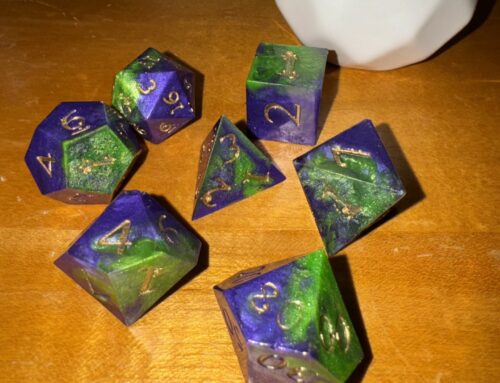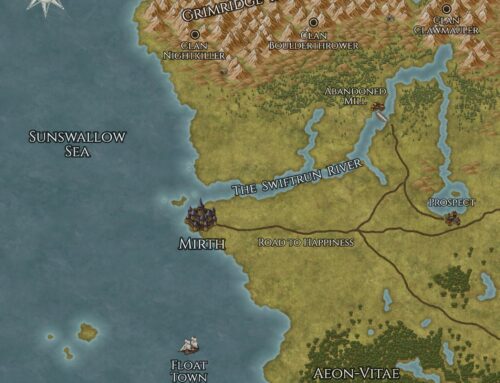Answer: I have no idea—even after writing nine of them.
Maybe some authors have a formula that produces consistent results, but for me, the question is too nuanced to allow for a simple solution. Here’s why:
- No two novels are the same.
- I tend to work on other projects in between drafts, which artificially extends the timeline.
- I don’t consider a book “done” until it’s published.
In other words, the writing itself is but one portion of a much longer process that starts with choosing a worthy idea to pursue and ends the moment the product is available for purchase.

Sometimes it can feel like centuries pass between penning the prologue and typing “THE END.” Attribution: Alan Jacobs [Public domain], via Wikimedia Commons
Take Project 5, for example…
After writing the three books of The Renegade Chronicles and a standalone (and currently unpublished) Altaerran novel called Magic’s Daughter, I attempted to compose a book that would merge characters from both works. I abandoned it after 22 chapters because it felt like I was simply filling in the blanks, and truth be told, I was starting to burn out on sword-and-sorcery fantasy—as a writer and a reader.
I decided my next book would take a step in a drastically different direction. I chose the working title “Project 5” because, well, I hoped it would yield my fifth complete novel. (Not very creative, Ghost of David Past!)
In June 2006, I began plotting an urban fantasy novel set in present-day Earth. The cast included Benedict Strong, a nearly immortal magic-caster who defied his heritage by trying to live a normal life; Lady Pandora, a stage magician who used real sorcery in her shows; and a few others.
I wrote a couple chapters before losing interest.
Next, I embraced a completely new plot — a fantasy/sci-fi hybrid that would eventually become If Souls Can Sleep. Once that story got its hooks in me, there was no turning back. Here’s a snapshot of the steps leading from inception to publication:
Dec. 10, 2006 — Began brainstorming a new Project 5, starting with rough character descriptions.
Dec. 31, 2006 — Wrote the prologue and began researching sleep disorders while hashing out ideas for the plot.
March 5, 2007 — Wrote the first chapter and then drafted a chapter a month for the next two years.
Oct. 30, 2008 — Realized that I was trying to write three books in one; removed select scenes from the first draft and saved them for Books 2 and 3.
April 7, 2009 — Developed an outline for the remainder of the novel after finishing Chapter 24 to prevent “writing in circles.”
July 1, 2009 — Finished the first complete draft of If Souls Can Sleep.
July – September 2009 — Read through the first draft and made notes for editing.
Oct. 18, 2009 — Started working on the heavy edits.
May 2, 2010 — Finished the second draft.
May 3, 2010 – Sept. 4, 2017 — Did lots of other stuff.*
Sept. 5, 2017 — After finishing the second draft of Book 3 in The Soul Sleep Cycle, jumped into proofing and prepping If Souls Can Sleep for publication through One Million Words.
Sept. 20, 2017 — Finished the production and marketing schedule.
Sept. 21, 2017 – Jan. 29, 2018 — Tackled/tackling all of the tasks required to publish and promote the book.
Jan. 30, 2018 — Publishing If Souls Can Sleep.
* Nota bene: I set aside If Souls Can Sleep for seven and a half years while I worked on a variety of other projects, including writing and editing the next two books in The Soul Sleep Cycle; co-writing and publishing a children’s chapter book (The Pajamazon Amazon vs The Goofers Twofers) with my wife; writing a few short stories (“The Lake Road,” “The Monster and the Mirage,” and “Ghost Mode”); reworking and submitting “Ghost Mode” and an older story, “Going Viral,” to various publications; and publishing the three novels and a digital collection comprising The Renegade Chronicles as well as a free e-book compendium (Capricon and Beyond). I also spent time marketing The Renegade Chronicles, creating an unsuccessful Kickstarter campaign for a pun-a-day calendar, and making this website during that time.
You could say that If Souls Can Sleep will be 11 years in the making when it publishes early next year—though, technically, the inception for the series goes back even further.
According to the first entry in my Project 5 notes, dated Dec. 10, 2006:
Years and years ago, I thought that it might be fun to write a story about a man who meets a woman that he swears he knows. And she seems to recognize him, though neither can say from where. At some point, he would recall her as a recurring character in his dreams.
There was, of course, more to the story, but a lingering question has (in a sense) haunted me from that point forward: Who are the strangers that appear in our dreams? Are they real people whose names we have forgotten—or perhaps never knew—or are they amalgamations that our minds concoct when it needs nonspecific characters for a scene?
My next book will contend that dream strangers are real people, even if they do not exist in what most would call the real world.
“Years and years ago”?
That initial inkling has evolved—maybe “mutated” is a better word—over the course of decades, which only underscores my belief that the life of a story spans far longer than the time it takes to write it down.
Regardless of when this labor of love actually began, one thing remains true: I’m looking forward to finally sharing If Souls Can Sleep with the world in 2018!
Don’t miss the release! Sign up for my monthly newsletter.



Okay, now I want to read this book. Will it be available on Kindle?
My current book has taken me two years so far. I thought it was done in a few months, but then I started rewriting the whole thing. Now the initial draft is finally done, and I’ve started re-reading for continuity, adding description and movement to scenes, that sort of thing.
But when did I *really* start this book? 1986! Yes, all the way back in high school. I wrote it in four sections, as a novella between 86 and I think 1990. I rewrote it a few years later in college for Fiction class, but the teacher didn’t even like sci-fi and said she couldn’t help me. (What kind of Fiction teacher can’t help at all with crafting a story just because of the genre?)
Anyway, I put the story aside because it needed lots of research, and I had other things to do. Over the years, it was almost forgotten. Then around 2009 or 2010, I found it in my old school papers, and decided to type it up onto my website as “juvenilia.” I wanted to put a bunch of my childhood/high school stories on the site, but still haven’t gotten around to it, partially because I don’t know where they all are… Anyway, it ended up here: https://nyssashobbithole.com/wordpress/writing/unwilling-time-traveler/
The funny thing is, though, even typing it up became an abandoned project. I typed up two parts and then forgot all about it until 2015. I don’t recall what made me pull it out again; maybe I was cleaning and found the original manuscript, or maybe I was updating my website and found the abandoned pages.
So I started typing it again, remembered that it desperately needed fleshing out along with lots of research, and got bitten by the bug again. I’ve been obsessed with it ever since. The plotline has totally transformed, reflecting serious research and life experience and learning the craft, but the main characters are still there.
So–a book that has taken 31 years to write? 🙂
Yes, I’ll be releasing in paperback and Kindle e-book simultaneously…with other e-book formats to follow.
I’m having flashbacks from one of my college writing workshops. We were told in one case that genre fiction was not allowed. So I wrote a blasé campus-life story. When my peers tore it down, I agreed with them; it was boring. The professor asked why, and I explained that I write speculative fiction. After that, she allowed genre submissions, and we had some pretty cool stuff contributed…you know, because people were allowed to write what they were passionate about.
I’m not sure 31 years is a record for writing a book, but you’ve got me beat. My personal “best” is 18 years for Rebels and Fools; I started it freshman year of college (1997) and published it in early 2016.
Of course, I created two of the characters in 6th grade, so, technically, the project began in 1990, making the project 25ish. 😉
Makes me wonder if it was the same professor. 😉 She kept making us read (boring) memoirs in class which had no plot and, well, weren’t even fiction. Several of us were disgruntled because we preferred sci-fi and the like. The previous year’s Fiction teacher was much better, actually giving us a textbook with classic short stories to read, and letting us write whatever we wanted.
Probably not the same professor, but a prevailing mentality in some faculty that commercial fiction is anathema and only non-genre fiction is true literature. Alas…